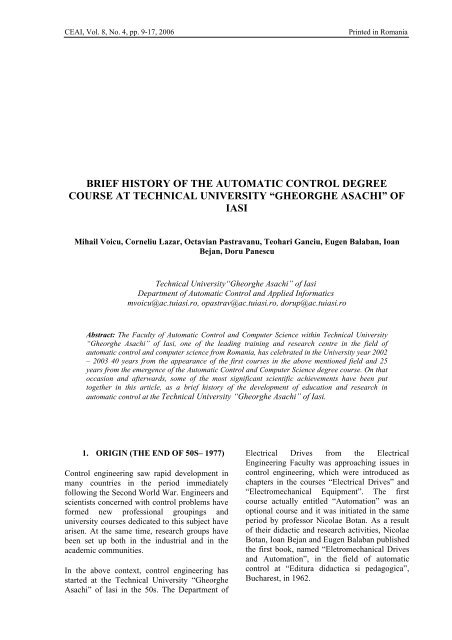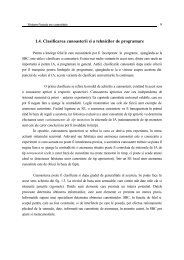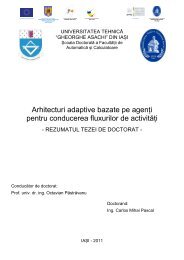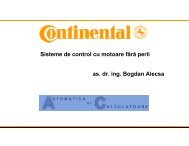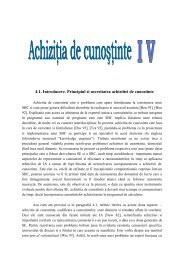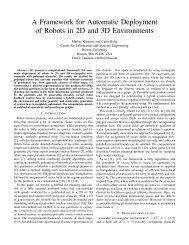Brief History of the Automatic Control Degree Course at Technical ...
Brief History of the Automatic Control Degree Course at Technical ...
Brief History of the Automatic Control Degree Course at Technical ...
You also want an ePaper? Increase the reach of your titles
YUMPU automatically turns print PDFs into web optimized ePapers that Google loves.
CEAI, Vol. 8, No. 4, pp. 9-17, 2006 Printed in Romania<br />
BRIEF HISTORY OF THE AUTOMATIC CONTROL DEGREE<br />
COURSE AT TECHNICAL UNIVERSITY “GHEORGHE ASACHI” OF<br />
IASI<br />
Mihail Voicu, Corneliu Lazar, Octavian Pastravanu, Teohari Ganciu, Eugen Balaban, Ioan<br />
Bejan, Doru Panescu<br />
<strong>Technical</strong> University“Gheorghe Asachi” <strong>of</strong> Iasi<br />
Department <strong>of</strong> <strong>Autom<strong>at</strong>ic</strong> <strong>Control</strong> and Applied Inform<strong>at</strong>ics<br />
mvoicu@ac.tuiasi.ro, opastrav@ac.tuiasi.ro, dorup@ac.tuiasi.ro<br />
Abstract: The Faculty <strong>of</strong> <strong>Autom<strong>at</strong>ic</strong> <strong>Control</strong> and Computer Science within <strong>Technical</strong> University<br />
“Gheorghe Asachi” <strong>of</strong> Iasi, one <strong>of</strong> <strong>the</strong> leading training and research centre in <strong>the</strong> field <strong>of</strong><br />
autom<strong>at</strong>ic control and computer science from Romania, has celebr<strong>at</strong>ed in <strong>the</strong> University year 2002<br />
– 2003 40 years from <strong>the</strong> appearance <strong>of</strong> <strong>the</strong> first courses in <strong>the</strong> above mentioned field and 25<br />
years from <strong>the</strong> emergence <strong>of</strong> <strong>the</strong> <strong>Autom<strong>at</strong>ic</strong> <strong>Control</strong> and Computer Science degree course. On th<strong>at</strong><br />
occasion and afterwards, some <strong>of</strong> <strong>the</strong> most significant scientific achievements have been put<br />
toge<strong>the</strong>r in this article, as a brief history <strong>of</strong> <strong>the</strong> development <strong>of</strong> educ<strong>at</strong>ion and research in<br />
autom<strong>at</strong>ic control <strong>at</strong> <strong>the</strong> <strong>Technical</strong> University “Gheorghe Asachi” <strong>of</strong> Iasi.<br />
1. ORIGIN (THE END OF 50S– 1977)<br />
<strong>Control</strong> engineering saw rapid development in<br />
many countries in <strong>the</strong> period immedi<strong>at</strong>ely<br />
following <strong>the</strong> Second World War. Engineers and<br />
scientists concerned with control problems have<br />
formed new pr<strong>of</strong>essional groupings and<br />
university courses dedic<strong>at</strong>ed to this subject have<br />
arisen. At <strong>the</strong> same time, research groups have<br />
been set up both in <strong>the</strong> industrial and in <strong>the</strong><br />
academic communities.<br />
In <strong>the</strong> above context, control engineering has<br />
started <strong>at</strong> <strong>the</strong> <strong>Technical</strong> University “Gheorghe<br />
Asachi” <strong>of</strong> Iasi in <strong>the</strong> 50s. The Department <strong>of</strong><br />
Electrical Drives from <strong>the</strong> Electrical<br />
Engineering Faculty was approaching issues in<br />
control engineering, which were introduced as<br />
chapters in <strong>the</strong> courses “Electrical Drives” and<br />
“Electromechanical Equipment”. The first<br />
course actually entitled “Autom<strong>at</strong>ion” was an<br />
optional course and it was initi<strong>at</strong>ed in <strong>the</strong> same<br />
period by pr<strong>of</strong>essor Nicolae Botan. As a result<br />
<strong>of</strong> <strong>the</strong>ir didactic and research activities, Nicolae<br />
Botan, Ioan Bejan and Eugen Balaban published<br />
<strong>the</strong> first book, named “Eletromechanical Drives<br />
and Autom<strong>at</strong>ion”, in <strong>the</strong> field <strong>of</strong> autom<strong>at</strong>ic<br />
control <strong>at</strong> “Editura didactica si pedagogica”,<br />
Bucharest, in 1962.
10 CONTROL ENGINEERING AND APPLIED INFORMATICS<br />
O<strong>the</strong>r compulsory courses have been established<br />
prior to 1962, which were mainly focused on <strong>the</strong><br />
requirements <strong>of</strong> electrical and power<br />
engineering programmes. This was <strong>the</strong> case with<br />
<strong>the</strong> course <strong>of</strong> “Autom<strong>at</strong>ion and Remote <strong>Control</strong>”<br />
(within <strong>the</strong> two degree courses) and <strong>the</strong> course<br />
on “Relays protection” (for <strong>the</strong> electrical power<br />
engineering programme) taught by pr<strong>of</strong>essors<br />
Leopold Sebastian and Ioan Bejan. In 1967, Ioan<br />
Bejan and Gherghina Balaban published <strong>the</strong> first<br />
course in control, entitled “Autom<strong>at</strong>ion and<br />
Remote <strong>Control</strong>” <strong>at</strong> <strong>the</strong> publishing house <strong>of</strong> <strong>the</strong><br />
University <strong>of</strong> Medicine and Pharmacy “Gr. T.<br />
Popa” <strong>of</strong> Iasi.<br />
In <strong>the</strong> 60s and <strong>the</strong> beginning <strong>of</strong> <strong>the</strong> 70s, <strong>the</strong><br />
course <strong>of</strong> “Autom<strong>at</strong>ion and Remote <strong>Control</strong>” has<br />
known a rapid development, e.g. <strong>the</strong> course<br />
“<strong>Autom<strong>at</strong>ic</strong> <strong>Control</strong>” (Leopold Sebastian)<br />
started <strong>at</strong> <strong>the</strong> electrical engineering programme<br />
and <strong>the</strong> course “Autom<strong>at</strong>ion <strong>of</strong> Electrical Power<br />
Systems” (Ioan Bejan) was introduced for <strong>the</strong><br />
electrical power engineering programme. New<br />
optional courses have also simultaneously<br />
appeared for electrical engineering, such as:<br />
“Logical Circuits and Sequential <strong>Control</strong><br />
Systems” (Corneliu Hutanu),<br />
“Servomechanisms” (Iosif Olah), “Computer<br />
<strong>Control</strong>led Processes” (Simona Caba) and<br />
“Advanced Autom<strong>at</strong>ion” (Gherghina Balaban,<br />
Iosif Olah and Mihail Voicu).<br />
Under <strong>the</strong> supervision <strong>of</strong> pr<strong>of</strong>essors Ioan Bejan<br />
and Leopold Sebastian extensive research have<br />
been carried out <strong>at</strong> <strong>the</strong> Department <strong>of</strong> Electrical<br />
Drives ranging from control <strong>the</strong>ory problems<br />
(nonlinear systems, identific<strong>at</strong>ion, adaptive and<br />
optimal control, controller tuning) to <strong>the</strong><br />
applic<strong>at</strong>ion <strong>of</strong> control methods in <strong>the</strong> areas <strong>of</strong><br />
<strong>the</strong>rmal processes, electrical drives, electrical<br />
power systems, relays protection systems,<br />
servomechanisms or machines tools control. The<br />
above mentioned pr<strong>of</strong>essors have initi<strong>at</strong>ed PhD<br />
positions in Industrial Autom<strong>at</strong>ion (Leopold<br />
Sebastian – 1966) and in Electrical Power<br />
System Autom<strong>at</strong>ion (Ioan Bejan – 1972). Then,<br />
two research groups have emerged, headed by<br />
Leopold Sebastian for <strong>the</strong> electrical engineering<br />
programme (Eugen Balaban, Corneliu Hutanu,<br />
Iosif Olah, Corneliu Botan, Teohari Ganciu and<br />
Simona Caba) and Ioan Bejan for <strong>the</strong> electrical<br />
power engineering programme, respectively<br />
(Gherghina Balaban, Ioan Titaru, Mihail Voicu,<br />
Cristea Pal and Dumitru Asandei).<br />
Due to <strong>the</strong> fact th<strong>at</strong> <strong>the</strong>se groups were <strong>at</strong> th<strong>at</strong><br />
time <strong>the</strong> only ones <strong>of</strong>fering courses in autom<strong>at</strong>ic<br />
control, one <strong>of</strong> <strong>the</strong> main tasks was from <strong>the</strong> very<br />
beginning to write manuals and monographs. In<br />
<strong>the</strong> 70s, several well-known books have been<br />
published in Romanian, e.g.:<br />
• L. Sebastian, “<strong>Autom<strong>at</strong>ic</strong> <strong>Control</strong>”,<br />
Editura didactica si pedagogica,<br />
Bucharest, 1975;<br />
• I. Bejan, “Autom<strong>at</strong>ion and remote<br />
control <strong>of</strong> electrical power systems”,<br />
Editura didactica si pedagogica,<br />
Bucharest, 1976;<br />
• I. Bejan, “Magnetic amplifier for control<br />
systems”, Editura Tehnica, Bucharest,<br />
1972;<br />
• N. V. Botan, “Speed control <strong>of</strong> electrical<br />
drives”, Editura Tehnica, Bucharest,<br />
1974;<br />
• N. V. Botan, “Electrical drives control”,<br />
Editura Tehnica, Bucharest, 1977.<br />
In <strong>the</strong> above mentioned period, PhD degrees in<br />
<strong>the</strong> field <strong>of</strong> autom<strong>at</strong>ic control have been<br />
obtained by Mihail Voicu, Corneliu Botan,<br />
Gherghina Balaban and Iosif Olah.<br />
Also in <strong>the</strong> same period, <strong>the</strong> members <strong>of</strong> <strong>the</strong><br />
autom<strong>at</strong>ic control group were awarded <strong>the</strong><br />
following prizes:<br />
• <strong>the</strong> Ministry <strong>of</strong> Educ<strong>at</strong>ion Prize – Ioan<br />
Bejan, Nicolae Botan, Leopold<br />
Sebastian, Eugen Balaban and<br />
Gherghina Balaban;<br />
• Pr<strong>of</strong>essor Emeritus awarded by <strong>the</strong><br />
Ministry <strong>of</strong> Educ<strong>at</strong>ion – Ioan Bejan,<br />
Eugen Balaban and Iosif Olah.<br />
The members <strong>of</strong> <strong>the</strong> autom<strong>at</strong>ic control group<br />
were involved in different types <strong>of</strong><br />
collabor<strong>at</strong>ive activities with <strong>the</strong> industrial<br />
companies developed in <strong>the</strong> eastern region<br />
<strong>of</strong> <strong>the</strong> country, such as: Design and<br />
implement<strong>at</strong>ion <strong>of</strong> voltage controllers<br />
(research projects funded by <strong>the</strong> Electric<br />
Power Company – IRE Gal<strong>at</strong>i and <strong>the</strong><br />
Electric Power Company – IRE Iasi);<br />
Design and implement<strong>at</strong>ion <strong>of</strong> digital<br />
circuits and modules for autom<strong>at</strong>ion<br />
(research project funded by <strong>the</strong> Bearing<br />
Manufacturing Enterprise Barlad);<br />
Retraining courses <strong>of</strong> autom<strong>at</strong>ion for
CONTROL ENGINEERING AND APPLIED INFORMATICS 11<br />
engineers working in power plants and<br />
power distribution<br />
2. FIRST AUTOMATIC CONTROL<br />
PROGRAMME (1977 – 1990)<br />
In 1977, a five years programme entitled<br />
“<strong>Autom<strong>at</strong>ic</strong> <strong>Control</strong> and Computers” has been<br />
developed within <strong>the</strong> Faculty <strong>of</strong> Electrical<br />
Engineering. This came as a response to <strong>the</strong><br />
demands from industry, which began to require<br />
well prepared engineers in <strong>the</strong> fields <strong>of</strong> control<br />
and computer science.<br />
This study programme began in 1977. There<br />
were two groups <strong>of</strong> first-year students which<br />
took entrance examin<strong>at</strong>ion <strong>at</strong> <strong>the</strong> new degree<br />
course and o<strong>the</strong>r two <strong>of</strong> second-year students<br />
transferred from <strong>the</strong> electrical and electronics<br />
programmes. Each group <strong>of</strong> students, in <strong>the</strong> first<br />
and second year respectively, had separ<strong>at</strong>e<br />
curricula, one for <strong>Autom<strong>at</strong>ic</strong> <strong>Control</strong> within <strong>the</strong><br />
Electrical Drives Department and <strong>the</strong> o<strong>the</strong>r for<br />
Computers functioning <strong>at</strong> <strong>the</strong> Electronics<br />
Department.<br />
As it has been mentioned in <strong>the</strong> previous<br />
section, <strong>at</strong> <strong>the</strong> Electrical Drives Department<br />
<strong>the</strong>re were already teaching staff and research<br />
labor<strong>at</strong>ories in <strong>the</strong> field <strong>of</strong> control engineering.<br />
The control team elabor<strong>at</strong>ed <strong>the</strong> first <strong>Autom<strong>at</strong>ic</strong><br />
<strong>Control</strong> curriculum th<strong>at</strong> comprised courses <strong>of</strong><br />
System <strong>the</strong>ory, Digital control systems,<br />
Analogue control systems, System<br />
identific<strong>at</strong>ion, Hydraulic and pneum<strong>at</strong>ic control<br />
equipment, <strong>Control</strong> system design, Systems and<br />
equipment for process control and Optimal<br />
control. The scientific research <strong>of</strong> <strong>the</strong> autom<strong>at</strong>ic<br />
control staff has known a significant progress<br />
characterized by several research projects, <strong>the</strong><br />
publishing <strong>of</strong> monographs and particip<strong>at</strong>ion <strong>at</strong><br />
intern<strong>at</strong>ional conferences.<br />
In <strong>the</strong> 80s, <strong>the</strong> following new areas <strong>of</strong> research<br />
have appeared: flow-invariance in control<br />
<strong>the</strong>ory, computer controlled processes, machine<br />
vision, p<strong>at</strong>tern recognition, computer aided<br />
control engineering and robotics. In 1983<br />
pr<strong>of</strong>essor Hutanu’s book “Digital circuits and<br />
sequential control systems” was published <strong>at</strong><br />
“Junimea” publishing house from Iasi and<br />
pr<strong>of</strong>essor Voicu published an important<br />
monograph <strong>at</strong> “Editura Tehnica”, Bucharest, in<br />
1986, entitled “Stability analysis techniques for<br />
control systems”.<br />
The deep crisis experienced by Romania in <strong>the</strong><br />
80s particularly affected higher educ<strong>at</strong>ion and<br />
inevitably, also <strong>the</strong> autom<strong>at</strong>ic control teaching<br />
staff, which faced serious problems. For<br />
example only three teaching assistants were<br />
admitted as PhD students in th<strong>at</strong> period in <strong>the</strong><br />
field <strong>of</strong> autom<strong>at</strong>ic control. It was extremely<br />
difficult, from an administr<strong>at</strong>ive point <strong>of</strong> view,<br />
to publish abroad or to particip<strong>at</strong>e <strong>at</strong><br />
intern<strong>at</strong>ional conferences. However, under <strong>the</strong>se<br />
severe conditions, 10 papers have still been<br />
published in important foreign journals by<br />
Voicu, Sebastian, Pastravanu and Ganciu and 9<br />
papers appeared in <strong>the</strong> proceedings <strong>of</strong><br />
intern<strong>at</strong>ional conferences. In this respect, <strong>the</strong><br />
papers published by pr<strong>of</strong>essor Voicu <strong>at</strong> <strong>the</strong> 9 th<br />
IFAC World Congress in Budapest (1984) and<br />
<strong>at</strong> <strong>the</strong> 10 th IFAC World Congress in Munich<br />
(1987) can be considered as remarkable<br />
achievements. Also, Pastravanu presented<br />
papers <strong>at</strong> <strong>the</strong> intern<strong>at</strong>ional conferences<br />
”Symposium on Systems Science IX” organized<br />
by University <strong>of</strong> Wroclaw (1986), “European<br />
Congress <strong>of</strong> Simul<strong>at</strong>ion” organized by<br />
Czechoslovak Academy <strong>of</strong> Science in<br />
cooper<strong>at</strong>ion with IMACS <strong>at</strong> Prague (1987) and<br />
<strong>the</strong> 4th Intern<strong>at</strong>ional Symposium on Systems<br />
Analysis and Simul<strong>at</strong>ion organized by DDR<br />
Academy <strong>of</strong> Science in cooper<strong>at</strong>ion with<br />
IMACS <strong>at</strong> Berlin (1988), and Lazar presented a<br />
paper <strong>at</strong> “The 3 rd Intern<strong>at</strong>ional Conference on<br />
<strong>Autom<strong>at</strong>ic</strong> Image Processing” organized by<br />
Scientific Technological Society for<br />
Measurement and <strong>Autom<strong>at</strong>ic</strong> <strong>Control</strong> and DDR<br />
Academy <strong>of</strong> Science <strong>at</strong> Leipzig (1989).<br />
The main difficulties in teaching and research<br />
activities were caused by <strong>the</strong> lack <strong>of</strong> computer<br />
facilities. Notable efforts were done by <strong>the</strong><br />
teaching assistants Octavian Pastravanu and<br />
Corneliu Lazar in <strong>the</strong> mid 80s, which were<br />
supported by <strong>the</strong> dean <strong>of</strong> <strong>the</strong> Faculty, pr<strong>of</strong>essor<br />
Ioan Bejan and by pr<strong>of</strong>essor Mihail Voicu, in<br />
order to achieve proper computer equipment and<br />
s<strong>of</strong>tware and to develop labor<strong>at</strong>ories for<br />
computer aided control engineering.<br />
Beginning with 1987, <strong>the</strong> control group formed<br />
within <strong>the</strong> teaching staff <strong>of</strong> <strong>the</strong> Electrical Drives<br />
Department organized every two years <strong>the</strong><br />
n<strong>at</strong>ional scientific symposium “Structures,<br />
Algorithms and Equipment for Process<br />
<strong>Control</strong>”.<br />
During <strong>the</strong> period discussed in <strong>the</strong> current<br />
section, <strong>the</strong> control engineering group supported
12 CONTROL ENGINEERING AND APPLIED INFORMATICS<br />
<strong>the</strong> technology research and development in <strong>the</strong><br />
field <strong>of</strong> autom<strong>at</strong>ion and robotics by fruitful<br />
cooper<strong>at</strong>ion with research institutes and<br />
industrial companies. The most important<br />
projects approached within this framework are<br />
listed below: Computer-assisted optimiz<strong>at</strong>ion in<br />
power distribution (funded by <strong>the</strong> Electric<br />
Power Company – IRE Bacau); Design and<br />
implement<strong>at</strong>ion <strong>of</strong> voltage controllers (funded<br />
by <strong>the</strong> Electric Power Company – IRE Gal<strong>at</strong>i);<br />
Performance improvement <strong>of</strong> several types <strong>of</strong><br />
controlled plants (funded by <strong>the</strong> Electric Power<br />
Company – IRE Iasi and <strong>the</strong> Electric Power<br />
Company – IRE Suceava); PLC-based control <strong>of</strong><br />
robotized cells (funded by <strong>the</strong> Metal Processing<br />
Company – IAM Tecuci); Design,<br />
implement<strong>at</strong>ion and testing <strong>of</strong> control equipment<br />
(funded by <strong>the</strong> Transducers and <strong>Control</strong>lers<br />
Company – ITRD Pascani, and <strong>the</strong> Pneum<strong>at</strong>ic<br />
equipment – FEPA Barlad); Computer vision<br />
applic<strong>at</strong>ions in textile industry (funded by <strong>the</strong><br />
Computing Centre – CTCE Suceava); Parameter<br />
estim<strong>at</strong>ion in biosyn<strong>the</strong>sis processes (funded by<br />
<strong>the</strong> Computing Centre – CTCE Iasi); S<strong>of</strong>tware<br />
development for <strong>the</strong> identific<strong>at</strong>ion <strong>of</strong> unknown<br />
inform<strong>at</strong>ion sources (funded by <strong>the</strong> Computing<br />
Research Institute – ITC Bucharest); Computergraphics<br />
tools for CNC machines (funded by <strong>the</strong><br />
Autom<strong>at</strong>ion Research Institute – IPA<br />
Bucharest).<br />
In <strong>the</strong> mid 80s, pr<strong>of</strong>essor Teohari Ganciu<br />
concentr<strong>at</strong>ed his efforts on <strong>the</strong> found<strong>at</strong>ion <strong>of</strong> <strong>the</strong><br />
Iasi branch <strong>of</strong> <strong>the</strong> “Autom<strong>at</strong>ion Research<br />
Institute” – IPA Bucharest.<br />
3. THE FACULTY OF AUTOMATIC<br />
CONTROL AND COMPUTER<br />
ENGINEERING<br />
As a direct consequence <strong>of</strong> <strong>the</strong> pr<strong>of</strong>ound<br />
changes experienced by <strong>the</strong> Romanian n<strong>at</strong>ion in<br />
1989, <strong>the</strong> Romanian higher educ<strong>at</strong>ional system<br />
has known a lively development. The Faculty <strong>of</strong><br />
Electrical Engineering has split in 1990 in three<br />
faculties. One <strong>of</strong> <strong>the</strong>se, <strong>the</strong> Faculty <strong>of</strong> <strong>Autom<strong>at</strong>ic</strong><br />
<strong>Control</strong> and Computer Engineering has been<br />
founded <strong>at</strong> <strong>the</strong> initi<strong>at</strong>ive and due to <strong>the</strong> efforts <strong>of</strong><br />
<strong>the</strong> teaching staff from <strong>the</strong> degree course<br />
“<strong>Autom<strong>at</strong>ic</strong> <strong>Control</strong> and Computers” <strong>of</strong> <strong>the</strong><br />
former Electrical Engineering Faculty. Pr<strong>of</strong>essor<br />
Corneliu Hutanu was <strong>the</strong> first dean <strong>of</strong> <strong>the</strong><br />
Faculty from 1990 to 1992. From <strong>the</strong> beginning,<br />
<strong>the</strong> Faculty had two departments, <strong>Autom<strong>at</strong>ic</strong><br />
<strong>Control</strong> and Industrial Inform<strong>at</strong>ics and<br />
Computer Science, each <strong>of</strong> <strong>the</strong>m <strong>of</strong>fering <strong>the</strong><br />
following degree courses: <strong>Autom<strong>at</strong>ic</strong> <strong>Control</strong><br />
and Industrial Inform<strong>at</strong>ics and Computer<br />
Science, respectively.<br />
The first head <strong>of</strong> <strong>the</strong> <strong>Autom<strong>at</strong>ic</strong> <strong>Control</strong> and<br />
Industrial Inform<strong>at</strong>ics department, pr<strong>of</strong>essor<br />
Mihail Voicu, toge<strong>the</strong>r with <strong>the</strong> department staff<br />
began in 1990 to develop a new curriculum in<br />
<strong>Autom<strong>at</strong>ic</strong> <strong>Control</strong> and Industrial Inform<strong>at</strong>ics. It<br />
must be noted th<strong>at</strong> this curriculum was also<br />
influenced by a consult<strong>at</strong>ive council <strong>of</strong> <strong>the</strong><br />
<strong>Autom<strong>at</strong>ic</strong> <strong>Control</strong> pr<strong>of</strong>essors from Romania in<br />
order to maintain certain comp<strong>at</strong>ibilities<br />
between similar curricula introduced in o<strong>the</strong>r<br />
university centres <strong>of</strong> <strong>the</strong> country. Starting with<br />
<strong>the</strong> beginning <strong>of</strong> <strong>the</strong> 90s, this curriculum has<br />
been changed and improved on a yearly basis,<br />
also based on <strong>the</strong> knowledge and <strong>the</strong> experience<br />
<strong>of</strong> o<strong>the</strong>r European universities, with which<br />
several contacts have been renewed or new<br />
established in <strong>the</strong> framework <strong>of</strong> EU<br />
programmes.<br />
Due to <strong>the</strong> efforts <strong>of</strong> Mihail Voicu and Octavian<br />
Pastravanu, Tempus Joint European Projects<br />
(JEPs) have been developed in collabor<strong>at</strong>ion<br />
with <strong>the</strong> <strong>Control</strong> Engineering departments <strong>of</strong><br />
o<strong>the</strong>r European universities, e.g. JEP 0886/1990<br />
"Higher Educ<strong>at</strong>ion in <strong>Control</strong> Engineering", JEP<br />
02011/1991 "Improvement in <strong>Autom<strong>at</strong>ic</strong><br />
<strong>Control</strong> Technologies", JEP 07101/1994<br />
"Development in Romania <strong>of</strong> Short-Term<br />
Higher Educ<strong>at</strong>ion in Computing, Centred on<br />
Distributed Processing and Its Applic<strong>at</strong>ion". The<br />
MJEP 11467/1996 “EU Comp<strong>at</strong>ible Training in<br />
Industrial Autom<strong>at</strong>ion” – COMPANION<br />
included six <strong>Autom<strong>at</strong>ic</strong> <strong>Control</strong> departments<br />
from Romania and four from abroad (Vienna,<br />
Duisburg, Sheffield, Ghent) and was<br />
coordin<strong>at</strong>ed by Mihail Voicu and Octavian<br />
Pastravanu. The last TEMPUS project <strong>of</strong> <strong>the</strong><br />
90’s, UM-JEP 13133/98 “Quality<br />
Management”, has been managed by Alexandru<br />
Onea and it has resulted in a significant<br />
contribution to <strong>the</strong> implement<strong>at</strong>ion <strong>of</strong> <strong>the</strong> quality<br />
assurance system <strong>of</strong> our Faculty.<br />
These projects also <strong>of</strong>fered a good opportunity<br />
for establishing rel<strong>at</strong>ionships between <strong>the</strong><br />
Department <strong>of</strong> <strong>Autom<strong>at</strong>ic</strong> <strong>Control</strong> and Industrial<br />
Inform<strong>at</strong>ics and o<strong>the</strong>r European Universities,<br />
which m<strong>at</strong>erialized in <strong>the</strong> particip<strong>at</strong>ion <strong>of</strong> all <strong>the</strong><br />
teaching staff to workshops organized by <strong>the</strong><br />
JEP members and dedic<strong>at</strong>ed to <strong>Control</strong><br />
Engineering Educ<strong>at</strong>ion and in <strong>the</strong> acquisition <strong>of</strong><br />
modern labor<strong>at</strong>ory setups. Due to <strong>the</strong> JEP
CONTROL ENGINEERING AND APPLIED INFORMATICS 13<br />
framework, most <strong>of</strong> <strong>the</strong> teaching staff and<br />
especially young PhD students had <strong>the</strong><br />
possibility to <strong>at</strong>tend training stages <strong>at</strong> <strong>the</strong> partner<br />
universities.<br />
Based on Tempus programmes, <strong>the</strong> “traditional”<br />
approach towards teaching has been modified<br />
substantially. The Faculty has accepted and<br />
implemented <strong>the</strong> European Credit Transfer<br />
System (ECTS) starting with <strong>the</strong> academic year<br />
1998 – 1999 and has made <strong>the</strong> teaching<br />
procedures comp<strong>at</strong>ible with similarly oriented<br />
universities in <strong>the</strong> world. This makes possible<br />
<strong>the</strong> exchange <strong>of</strong> students and academic staff and<br />
mutual recognition <strong>of</strong> study periods and<br />
qualific<strong>at</strong>ions.<br />
The European Credit Transfer System formed<br />
<strong>the</strong> basis <strong>of</strong> future collabor<strong>at</strong>ions th<strong>at</strong> continued<br />
after <strong>the</strong> end <strong>of</strong> <strong>the</strong> Tempus programme. Thus,<br />
with some <strong>of</strong> <strong>the</strong> partner universities, <strong>the</strong><br />
programme Socr<strong>at</strong>es-Erasmus began to grow <strong>at</strong><br />
<strong>the</strong> end <strong>of</strong> <strong>the</strong> 90s. In <strong>the</strong> framework <strong>of</strong> this<br />
programme, each year students from our<br />
department worked on <strong>the</strong> diploma project <strong>at</strong> <strong>the</strong><br />
following universities: University <strong>of</strong> Gent<br />
(Department <strong>of</strong> Electrical Energy, Systems &<br />
Autom<strong>at</strong>ion), University <strong>of</strong> Sheffield<br />
(Department <strong>of</strong> <strong>Autom<strong>at</strong>ic</strong> <strong>Control</strong> and System<br />
Engineering), University <strong>of</strong> Duisburg<br />
(Department <strong>of</strong> Measurement and <strong>Control</strong><br />
Engineering), Vienna University <strong>of</strong> Technology<br />
(Department <strong>of</strong> Robotics), Institut N<strong>at</strong>ional<br />
Polytechnique de Grenoble and Université<br />
Joseph Fourier (Labor<strong>at</strong>oire d’Autom<strong>at</strong>ique de<br />
Grenoble). Within this programme, an important<br />
number <strong>of</strong> MSc and PhD students had also<br />
training stages. Since 1999 till now, in <strong>the</strong><br />
framework <strong>of</strong> <strong>the</strong> Socr<strong>at</strong>es – Erasmus<br />
programme, pr<strong>of</strong>essor Robin De Keyser from<br />
<strong>the</strong> University <strong>of</strong> Ghent has taught each year a<br />
module <strong>of</strong> <strong>the</strong> Predictive <strong>Control</strong> Systems<br />
course for <strong>the</strong> MSc programme <strong>of</strong> our<br />
department. At <strong>the</strong> same time, pr<strong>of</strong>essors<br />
Corneliu Lazar and Octavian Pastravanu have<br />
taught mini-courses on Predictive <strong>Control</strong> and<br />
respectively Process Modelling Using Bond<br />
Graph in <strong>the</strong> last two years <strong>at</strong> <strong>the</strong> University <strong>of</strong><br />
Ghent.<br />
Toge<strong>the</strong>r with <strong>the</strong> development <strong>of</strong> a new<br />
curriculum for <strong>the</strong> <strong>Autom<strong>at</strong>ic</strong> control<br />
programme, <strong>at</strong> <strong>the</strong> beginning <strong>of</strong> <strong>the</strong> 90s, new<br />
teaching staff has been recruited from <strong>the</strong><br />
research institutes and young gradu<strong>at</strong>es. In 1992<br />
pr<strong>of</strong>essor Mihail Voicu, who had a strong<br />
experience in managing research and teaching<br />
staff, has become <strong>the</strong> dean <strong>of</strong> <strong>the</strong> Faculty. Since<br />
<strong>the</strong> same year, pr<strong>of</strong>essor Ganciu has been <strong>the</strong><br />
head <strong>of</strong> <strong>the</strong> department <strong>of</strong> <strong>Autom<strong>at</strong>ic</strong> <strong>Control</strong><br />
and Industrial Inform<strong>at</strong>ics.<br />
As a consequence <strong>of</strong> <strong>the</strong> pro-European<br />
orient<strong>at</strong>ion <strong>of</strong> <strong>the</strong> Romanian Higher Educ<strong>at</strong>ion<br />
th<strong>at</strong> appeared immedi<strong>at</strong>ely after 1990, our<br />
department was entitled to <strong>of</strong>fer a master<br />
programme – one year <strong>of</strong> specializ<strong>at</strong>ion,<br />
ensuring fur<strong>the</strong>r training in <strong>the</strong> following<br />
modern areas <strong>of</strong> <strong>Autom<strong>at</strong>ic</strong> <strong>Control</strong>: distributed<br />
parameter control systems, parallel<br />
programming algorithms and techniques,<br />
predictive control, parameter estim<strong>at</strong>ion,<br />
distributed control, artificial intelligence in<br />
control.<br />
Also, it must be mentioned th<strong>at</strong> due to <strong>the</strong><br />
changes th<strong>at</strong> took place in Romania <strong>at</strong> <strong>the</strong><br />
beginning <strong>of</strong> 90s, besides pr<strong>of</strong>essors Bejan and<br />
Sebastian, <strong>the</strong> pr<strong>of</strong>essors Voicu, Hutanu,<br />
Balaban, Botan and Olah have also received <strong>the</strong><br />
right to be PhD supervisors in <strong>Autom<strong>at</strong>ic</strong><br />
<strong>Control</strong>. Thus, new research areas have<br />
appeared and a gre<strong>at</strong>er number <strong>of</strong> gradu<strong>at</strong>es in<br />
<strong>Autom<strong>at</strong>ic</strong> <strong>Control</strong> have become PhD students,<br />
which ultim<strong>at</strong>ely led to an increased research<br />
activity. As a result <strong>of</strong> this, <strong>the</strong> number <strong>of</strong><br />
scientific works published in journals and <strong>at</strong><br />
intern<strong>at</strong>ional conferences and congresses has<br />
also increased considerably. Recently, <strong>the</strong><br />
Ministry <strong>of</strong> Educ<strong>at</strong>ion has also authorised<br />
pr<strong>of</strong>essor Pastravanu to promote and supervise<br />
PhD <strong>the</strong>ses.<br />
At <strong>the</strong> end <strong>of</strong> <strong>the</strong> 90s, wh<strong>at</strong> seemed to be a<br />
“n<strong>at</strong>ural” development took place, and <strong>the</strong><br />
research groups from <strong>the</strong> department <strong>of</strong><br />
<strong>Autom<strong>at</strong>ic</strong> <strong>Control</strong> and Industrial Inform<strong>at</strong>ics<br />
merged and <strong>the</strong>y formed <strong>the</strong> <strong>Autom<strong>at</strong>ic</strong> <strong>Control</strong><br />
and Applied Inform<strong>at</strong>ics (ACAI) Research<br />
Centre accredited by Ministry <strong>of</strong> Educ<strong>at</strong>ion and<br />
Research after <strong>the</strong> evalu<strong>at</strong>ion by <strong>the</strong> N<strong>at</strong>ional<br />
Council for Scientific Research in Higher<br />
Educ<strong>at</strong>ion. ACAI Research Centre, managed by<br />
pr<strong>of</strong>essor Mihail Voicu, was designed as an<br />
interdisciplinary research centre within <strong>the</strong><br />
Faculty <strong>of</strong> <strong>Autom<strong>at</strong>ic</strong> <strong>Control</strong> and Computer<br />
Science and its mission was to fulfil st<strong>at</strong>ements<br />
<strong>of</strong> <strong>the</strong> University and <strong>of</strong> <strong>the</strong> Faculty within <strong>the</strong><br />
field <strong>of</strong> Systems and <strong>Control</strong> Engineering by<br />
cre<strong>at</strong>ing and sustaining a world class research<br />
group. The main directions <strong>of</strong> <strong>the</strong> scientific<br />
research have been <strong>the</strong> following: System
14 CONTROL ENGINEERING AND APPLIED INFORMATICS<br />
Theory, Robotics and CIM, Optimal and<br />
Predictive <strong>Control</strong>, Artificial Intelligence in<br />
Process <strong>Control</strong>, Systems Identific<strong>at</strong>ion and<br />
Fault Detection, Microprocessor Based <strong>Control</strong><br />
Systems, CAD for Dynamic Systems.<br />
In 2005, a group <strong>of</strong> researchers separ<strong>at</strong>ed from<br />
<strong>the</strong> ACAI Research Centre and founded a new<br />
centre, called System Theory and Engineering,<br />
whose scientific interests focus on <strong>the</strong> following<br />
areas: Qualit<strong>at</strong>ive <strong>the</strong>ory <strong>of</strong> dynamical systems;<br />
Discrete event and hybrid systems; Artificial<br />
intelligence in autom<strong>at</strong>ic control. This centre has<br />
been recently ranked “Centre <strong>of</strong> excellence” by<br />
CNCSIS - The N<strong>at</strong>ional Council for Scientific<br />
Research in Higher Educ<strong>at</strong>ion.<br />
The staff <strong>of</strong> <strong>the</strong> two research centres had a very<br />
productive period from 2000 to 2005, publishing<br />
15 monographs and courses, 16 journal papers<br />
among which 14 in ISI journals and 121<br />
conference papers. Among <strong>the</strong>se public<strong>at</strong>ions, it<br />
should be mentioned <strong>the</strong> volume: M. Voicu<br />
(Ed.), Advances in <strong>Autom<strong>at</strong>ic</strong> <strong>Control</strong>, Kluwer<br />
Academic Publishers, Boston, 2004 (456 pp.),<br />
which contains 27 papers authored by members<br />
<strong>of</strong> our department and o<strong>the</strong>r well-known<br />
scientists from Romania, Germany, France,<br />
Austria, Czech Republic and United St<strong>at</strong>es, who,<br />
in various forms, developed collabor<strong>at</strong>ive works<br />
with our department. The two research centres<br />
have also carried out projects financed by <strong>the</strong><br />
Ministry <strong>of</strong> Educ<strong>at</strong>ion and Research, as well as<br />
by industrial companies (grant directors: Mihail<br />
Voicu, Corneliu Botan, Corneliu Lazar,<br />
Octavian Pastravanu, Alexandru Onea, Stefan<br />
Dumbrava, Lucian Mastacan, Letitia Mirea).<br />
In September 1998, <strong>the</strong> Faculty has been moved<br />
in a new building having 7700 m 2 useful area<br />
with 2 amphi<strong>the</strong><strong>at</strong>res, 7 lecture rooms, 30<br />
labor<strong>at</strong>ories and 32 <strong>of</strong>fices for <strong>the</strong> teaching staff.<br />
The two departments <strong>of</strong> <strong>the</strong> Faculty develop<br />
<strong>the</strong>ir activity in <strong>the</strong> new building beside <strong>the</strong><br />
Faculty Library and <strong>the</strong> Communic<strong>at</strong>ion Centre<br />
<strong>of</strong> <strong>the</strong> <strong>Technical</strong> University “Gheorghe Asachi”<br />
<strong>of</strong> Iasi. It is important to say th<strong>at</strong> <strong>the</strong> building<br />
has been started <strong>of</strong>f <strong>at</strong> <strong>the</strong> beginning <strong>of</strong> <strong>the</strong> 90s<br />
<strong>at</strong> <strong>the</strong> initi<strong>at</strong>ive <strong>of</strong> pr<strong>of</strong>essor Mihail Voicu,<br />
supported by pr<strong>of</strong>essor Ioan Bejan, to take <strong>the</strong><br />
initial necessary steps <strong>at</strong> <strong>the</strong> Ministry <strong>of</strong><br />
Educ<strong>at</strong>ion and Research.<br />
Unfortun<strong>at</strong>ely, <strong>the</strong> 90’s economic decline <strong>of</strong><br />
Romania cre<strong>at</strong>ed serious problems regarding<br />
higher educ<strong>at</strong>ion financing. As a result <strong>of</strong> this,<br />
several young people from <strong>the</strong> teaching staff left<br />
<strong>the</strong> department trying to fulfil <strong>the</strong>ir pr<strong>of</strong>essional<br />
careers in more developed countries. At <strong>the</strong><br />
same time serious difficulties have appeared in<br />
providing facilities for teaching and research<br />
work. However, <strong>the</strong> department members could<br />
adapt to <strong>the</strong> new forms <strong>of</strong> financing by having<br />
access to external funds, mainly from <strong>the</strong><br />
following sources: European Trading<br />
Found<strong>at</strong>ion – Tempus JEPs, Higher Educ<strong>at</strong>ion<br />
Financing Council <strong>of</strong> Ministry <strong>of</strong> Educ<strong>at</strong>ion and<br />
Research, World Bank, Romanian Government<br />
and industrial companies.<br />
Thus, during 1998 – 2003 <strong>the</strong> following five<br />
major projects have been financed by <strong>the</strong> World<br />
Bank and Romanian Government: System <strong>of</strong><br />
Integr<strong>at</strong>ed Labor<strong>at</strong>ories for Studying CIM<br />
(director Mihail Voicu – 216,000 USD),<br />
Training Labor<strong>at</strong>ory in <strong>the</strong> Field <strong>of</strong> Computer<br />
Aided Process <strong>Control</strong> (director Octavian<br />
Pastravanu – 150,000 USD), Labor<strong>at</strong>ory for<br />
Electrical Drives <strong>Control</strong> (director Corneliu<br />
Botan – 150,000 USD), Integr<strong>at</strong>ed Labor<strong>at</strong>ory<br />
for Studying, Designing and Implement<strong>at</strong>ion <strong>of</strong><br />
Digital Structure for Process <strong>Control</strong> (director<br />
Teohari Ganciu – 150,000 USD), Upgrading <strong>of</strong><br />
<strong>the</strong> Short Cycle <strong>Degree</strong> Programme on<br />
Autom<strong>at</strong>ion Equipment (director Alexandru<br />
Onea – 35,000 USD). There were also 2<br />
individual projects only for <strong>the</strong> equipment<br />
acquisition: Microprocessor Based <strong>Control</strong><br />
Systems (director Corneliu Hutanu – 5,000<br />
USD) and Digital <strong>Control</strong>ler for Process <strong>Control</strong><br />
(director – Corneliu Lazar – 5,000 USD). These<br />
funds allowed <strong>the</strong> development <strong>of</strong> new<br />
labor<strong>at</strong>ories and <strong>the</strong> upd<strong>at</strong>e <strong>of</strong> most <strong>of</strong> <strong>the</strong><br />
existent labor<strong>at</strong>ories <strong>at</strong> our department with <strong>the</strong><br />
following major facilities for teaching and<br />
research work:<br />
• Flexible Manufacturing System<br />
containing two ABB robots (IRB 1400<br />
and IRB 2400), machine tool (EMCO<br />
PC Mill), conveyor (FlexLink),<br />
computer vision system (OptiMaster),<br />
CAD system (8 PC st<strong>at</strong>ions); Robot<br />
Soccer System containing 8 MiaBot<br />
mobile robots and a computer vision<br />
system; Androtec mobile robot;<br />
• Process control setups: FieldPoint<br />
Distributed <strong>Control</strong> System (N<strong>at</strong>ional<br />
Instruments) for <strong>the</strong> distributed control<br />
<strong>of</strong> industrial processes, PROCON<br />
process control trainers for level, flow<br />
and temper<strong>at</strong>ure (Feedback),
CONTROL ENGINEERING AND APPLIED INFORMATICS 15<br />
LEYBOLD and ELWE electrical drive<br />
control trainers, Twin Rotor MIMO<br />
System (Feedback), Moeller PLCs,<br />
Labor<strong>at</strong>ory kits for teaching<br />
microprocessor based systems;<br />
• Labor<strong>at</strong>ory install<strong>at</strong>ion for making<br />
printed circuit boards (Lpkf Germany);<br />
• Computers: 45 computers (IBM<br />
comp<strong>at</strong>ible) with oper<strong>at</strong>ing systems and<br />
basic s<strong>of</strong>tware, 5 analogue COMDYNA<br />
computers, 7 d<strong>at</strong>a acquisition cards –<br />
N<strong>at</strong>ional Instruments ATMIO16E10<br />
with starter Kit and rel<strong>at</strong>ed drivers;<br />
• S<strong>of</strong>tware: CATIA V5R8 (CAD); Robot<br />
Studio (robot simul<strong>at</strong>ion s<strong>of</strong>tware),<br />
Eclipse, RT++, AgentOCX, LPA<br />
Prolog, Flex, Agent Toolkit (artificial<br />
intelligence s<strong>of</strong>tware), Sucos<strong>of</strong>t V5<br />
(PLC s<strong>of</strong>tware), Discovery computer<br />
control aided learning s<strong>of</strong>tware,<br />
MATLAB- Simulink 6.0, HMI/SCADA<br />
s<strong>of</strong>tware Lookout, Cadence s<strong>of</strong>tware<br />
(OrCAD) for PCB design.<br />
The above mentioned funds have also been used<br />
to purchase important textbooks in <strong>the</strong> field <strong>of</strong><br />
autom<strong>at</strong>ic control for <strong>the</strong> Faculty Library. They<br />
also contributed in <strong>the</strong> publishing <strong>of</strong><br />
monographs and university manuals, <strong>the</strong><br />
development <strong>of</strong> new courses in <strong>Autom<strong>at</strong>ic</strong><br />
<strong>Control</strong> degree programme, <strong>the</strong> finaliz<strong>at</strong>ion <strong>of</strong><br />
PhD <strong>the</strong>sis and <strong>the</strong> particip<strong>at</strong>ion <strong>at</strong> intern<strong>at</strong>ional<br />
conferences.<br />
Based on <strong>the</strong> experience accumul<strong>at</strong>ed from his<br />
last TEMPUS project, Alexandru Onea initi<strong>at</strong>ed<br />
and led o<strong>the</strong>r two projects having <strong>the</strong> same<br />
<strong>the</strong>me, quality assurance in higher educ<strong>at</strong>ion:<br />
MATRA project – “Developing <strong>the</strong> n<strong>at</strong>ional<br />
str<strong>at</strong>egy in <strong>the</strong> field <strong>of</strong> quality assurance in<br />
higher educ<strong>at</strong>ion in Romania”, financed by EU<br />
through <strong>the</strong> Dutch Government and <strong>the</strong><br />
Leonardo da Vinci project – “Training in quality<br />
management system for inform<strong>at</strong>ion technology<br />
in higher educ<strong>at</strong>ion”.<br />
Due to his outstanding contributions which are<br />
indexed in Zentralbl<strong>at</strong>t fuer Ma<strong>the</strong>m<strong>at</strong>ik (41<br />
reviewed papers) and in ISI Web <strong>of</strong> Knowledge<br />
(46 cited papers), pr<strong>of</strong>essor Mihail Voicu was<br />
elected, in 2006, corresponding member <strong>of</strong> <strong>the</strong><br />
Romanian Academy. Previously, pr<strong>of</strong>essor<br />
Mihail Voicu was elected corresponding<br />
member (in 1999) and full member (in 2004) <strong>of</strong><br />
<strong>the</strong> Romanian Academy <strong>of</strong> <strong>Technical</strong> Sciences.<br />
Since 1998 he is senior member <strong>of</strong> IEEE<br />
(<strong>Control</strong> Systems Society) and since 2004 he<br />
became Gre<strong>at</strong> Officer <strong>of</strong> <strong>the</strong> Romanian Order<br />
“Merit for Teaching”. Also, he has received <strong>the</strong><br />
“Aurel Vlaicu” prize <strong>of</strong> <strong>the</strong> Romanian Academy<br />
for <strong>the</strong> year 1987 (awarded 1990) for <strong>the</strong> papers:<br />
• M. Voicu, Observing <strong>the</strong> St<strong>at</strong>e with<br />
Componentwise Exponentially<br />
Decaying Error. Systems & <strong>Control</strong><br />
Letters 9 (1987), pp. 33 – 42.<br />
• M. Voicu, On <strong>the</strong> Applic<strong>at</strong>ion <strong>of</strong> <strong>the</strong><br />
Flow-Invariance Method in <strong>Control</strong><br />
Theory and Design. 10th World<br />
Congress <strong>of</strong> Intern<strong>at</strong>ional Feder<strong>at</strong>ion <strong>of</strong><br />
<strong>Autom<strong>at</strong>ic</strong> <strong>Control</strong>, Munich, July 26–31,<br />
1987. Preprints, vol. VIII, pp. 364–369.<br />
We have also to notice here th<strong>at</strong> due to his<br />
outstanding contributions which appear in ISI<br />
Web <strong>of</strong> Knowledge (12 papers cited in Web <strong>of</strong><br />
Science, 4 in Current Contents Connect, and 31<br />
in INSPEC), pr<strong>of</strong>essor Octavian Pastravanu was<br />
elected in 2005 corresponding member <strong>of</strong> <strong>the</strong><br />
Romanian Academy <strong>of</strong> <strong>Technical</strong> Sciences.<br />
Starting with <strong>the</strong> Academic year 2005 – 2006<br />
<strong>the</strong> Romanian higher educ<strong>at</strong>ion adhered to <strong>the</strong><br />
Bologna process. This supposed th<strong>at</strong> training in<br />
<strong>Autom<strong>at</strong>ic</strong> <strong>Control</strong> should be based on three<br />
cycles – Bachelor, Master and Doctor<strong>at</strong>e. The<br />
Bachelor degree has been established for a<br />
period <strong>of</strong> four years. The main point <strong>of</strong> <strong>the</strong><br />
curriculum was to provide <strong>the</strong> competence to <strong>the</strong><br />
gradu<strong>at</strong>es as <strong>the</strong> market required for a control<br />
engineer. The gradu<strong>at</strong>es’ skills were discussed<br />
by <strong>the</strong> consult<strong>at</strong>ive council <strong>of</strong> <strong>the</strong> <strong>Autom<strong>at</strong>ic</strong><br />
<strong>Control</strong> pr<strong>of</strong>essors from Romania, resulting in<br />
high degree <strong>of</strong> comp<strong>at</strong>ibility for <strong>the</strong> curricula <strong>of</strong><br />
all <strong>the</strong> Romanian universities. The first years <strong>of</strong><br />
<strong>the</strong> Bachelor programme are supposed to assure<br />
<strong>the</strong> background by means <strong>of</strong> knowledge in<br />
Ma<strong>the</strong>m<strong>at</strong>ics, Physics, Programming, Systems<br />
Theory, and <strong>the</strong> last years <strong>of</strong>fer <strong>the</strong> possibility<br />
th<strong>at</strong> students can choose between several<br />
optional courses, which may determine a deeper<br />
understanding <strong>of</strong> ei<strong>the</strong>r <strong>the</strong> process control field<br />
or <strong>the</strong> applied inform<strong>at</strong>ics. Taking into<br />
consider<strong>at</strong>ion <strong>the</strong> new name <strong>of</strong> <strong>the</strong> Bachelor<br />
specializ<strong>at</strong>ion – namely <strong>Autom<strong>at</strong>ic</strong> <strong>Control</strong> and<br />
Applied Inform<strong>at</strong>ics and also <strong>the</strong> research<br />
interest <strong>of</strong> our staff, starting with October 2005,<br />
<strong>the</strong> name <strong>of</strong> our department became Department<br />
<strong>of</strong> <strong>Autom<strong>at</strong>ic</strong> <strong>Control</strong> and Applied Inform<strong>at</strong>ics.<br />
The numerous contacts with <strong>the</strong> western<br />
universities permitted <strong>the</strong> change <strong>of</strong> <strong>the</strong> n<strong>at</strong>ional
16 CONTROL ENGINEERING AND APPLIED INFORMATICS<br />
scientific symposium <strong>of</strong> <strong>the</strong> Faculty in <strong>the</strong><br />
Intern<strong>at</strong>ional Symposium on <strong>Autom<strong>at</strong>ic</strong> <strong>Control</strong><br />
and Computer Science organized every two<br />
years, namely in 1993 and 1995 and every three<br />
years afterwards.<br />
Since 1991, owing to <strong>the</strong> initi<strong>at</strong>ive <strong>of</strong> pr<strong>of</strong>essor<br />
Mihail Voicu, <strong>the</strong> Bulletin <strong>of</strong> <strong>the</strong> Polytechnic<br />
Institute <strong>of</strong> Iasi has a new Section dedic<strong>at</strong>ed to<br />
<strong>Autom<strong>at</strong>ic</strong> <strong>Control</strong> and Computer Science,<br />
executive editors for <strong>the</strong> <strong>Autom<strong>at</strong>ic</strong> <strong>Control</strong> part<br />
being from <strong>the</strong> beginning till now Octavian<br />
Pastravanu, Doru Panescu and Alexandru Onea.<br />
This journal (indexed in Zentralbl<strong>at</strong>t d<strong>at</strong>a base)<br />
allowed <strong>the</strong> specialists in <strong>the</strong> autom<strong>at</strong>ic control<br />
field to point out <strong>the</strong> results <strong>of</strong> <strong>the</strong>ir scientific<br />
research activity.<br />
At <strong>the</strong> present time, <strong>the</strong> <strong>Autom<strong>at</strong>ic</strong> <strong>Control</strong><br />
degree programme and research programme <strong>at</strong><br />
<strong>the</strong> <strong>Technical</strong> University “Gheorghe Asachi” <strong>of</strong><br />
Iasi is carried out by <strong>the</strong> following teaching<br />
staff, <strong>of</strong> <strong>the</strong> <strong>Autom<strong>at</strong>ic</strong> <strong>Control</strong> and Applied<br />
Inform<strong>at</strong>ics Department from <strong>the</strong> Faculty <strong>of</strong><br />
<strong>Autom<strong>at</strong>ic</strong> <strong>Control</strong> and Computer Engineering:<br />
• Honorary Pr<strong>of</strong>essors: Eugen Balaban,<br />
Ioan Bejan, Corneliu Hutanu, Leopold<br />
Sebastian<br />
• Pr<strong>of</strong>essors: Corneliu Botan, Teohari<br />
Ganciu (vice-dean <strong>of</strong> <strong>the</strong> Faculty),<br />
Corneliu Lazar (vice-dean <strong>of</strong> <strong>the</strong><br />
Faculty), Iosif Olah, Cristea Pal, Doru<br />
Panescu (head <strong>of</strong> <strong>the</strong> Department),<br />
Octavian Pastravanu, Mihail Voicu<br />
(vice-rector <strong>of</strong> <strong>the</strong> University)<br />
• Associ<strong>at</strong>e Pr<strong>of</strong>essors: Stefan Dumbrava,<br />
Lavinia Ferariu, Lucian Mastacan,<br />
Mihaela M<strong>at</strong>covschi, Letitia Mirea,<br />
Alexandru Onea (editor <strong>of</strong> <strong>the</strong><br />
<strong>Autom<strong>at</strong>ic</strong> <strong>Control</strong> Section <strong>of</strong> <strong>the</strong><br />
Bulletin <strong>of</strong> <strong>the</strong> Polytechnic Institute <strong>of</strong><br />
Iasi), Andrei Pricop, Mihai Postolache,<br />
Gabriela Varvara<br />
• Lecturers: C<strong>at</strong>alin Calistru, Florin Ostafi<br />
• Teaching Assistants: C<strong>at</strong>alin Braescu,<br />
Sorin Carari, Vasile Dorin, C<strong>at</strong>alin<br />
Dos<strong>of</strong>tei, Marius Kloetzer, Mircea<br />
Lazar, Claudiu Lefter, Laurentiu<br />
Marinovici, Stefan Resmerita, Cristina<br />
Tugurlan<br />
• Junior Teaching Assistants: Cristian<br />
Mahulea, Draguna Vrabie<br />
• PhD students: Mircea Hulea, Ciprian<br />
Andrici, Cristina Halauca, Alexandru<br />
Toderascu<br />
Part <strong>of</strong> <strong>the</strong> above listed teaching assistants and<br />
junior teaching assistants are currently studying<br />
abroad as PhD students enrolled in several<br />
research programs developed by European or<br />
American Universities.<br />
It should be noticed here th<strong>at</strong>, in <strong>the</strong> nineties,<br />
many o<strong>the</strong>r colleagues were involved (for<br />
limited periods) in <strong>the</strong> teaching tasks and<br />
research programmes <strong>of</strong> <strong>the</strong> department. Among<br />
<strong>the</strong>se Silviu Ifrim, Teodor Marcu, Bogdan<br />
Morosan, Ileana Poli, and Francisc Schönberger<br />
also obtained <strong>the</strong> PhD degree before leaving <strong>the</strong><br />
department for o<strong>the</strong>r jobs (in USA, Canada,<br />
Germany, France, United Kingdom).<br />
The academic staff <strong>of</strong> our department brought a<br />
substantial contribution to <strong>the</strong> continuous<br />
development <strong>of</strong> <strong>Autom<strong>at</strong>ic</strong> <strong>Control</strong> in Romania<br />
by public<strong>at</strong>ions with a wide degree <strong>of</strong><br />
intern<strong>at</strong>ional visibility, as well as by<br />
particip<strong>at</strong>ions in <strong>the</strong> highly ranked conferences<br />
<strong>of</strong> <strong>the</strong> field, organized by intern<strong>at</strong>ional<br />
pr<strong>of</strong>essional societies, such as IFAC, IEEE,<br />
EUCA, IMACS, IFIP, IMEKO. During <strong>the</strong>ir<br />
activity, <strong>the</strong> academics <strong>of</strong> our department have<br />
published over 50 monographs and university<br />
courses, as well as a large number <strong>of</strong> journal and<br />
conference papers; among <strong>the</strong>se papers, 177 are<br />
recorded by <strong>the</strong> ISI Web <strong>of</strong> Knowledge (22<br />
papers cited in Web <strong>of</strong> Science, 9 in Current<br />
Contents Connect, and 146 in INSPEC). This<br />
inform<strong>at</strong>ion exclusively refers to <strong>the</strong> authors<br />
who are currently with <strong>the</strong> Department <strong>of</strong><br />
<strong>Autom<strong>at</strong>ic</strong> <strong>Control</strong> and Applied Inform<strong>at</strong>ics (and<br />
does not include <strong>the</strong> authors on leave from our<br />
department).<br />
After 1990, <strong>the</strong> higher educ<strong>at</strong>ion – industry<br />
liaison was m<strong>at</strong>erialized by different types <strong>of</strong><br />
partnerships between our department and several<br />
n<strong>at</strong>ional / intern<strong>at</strong>ional companies, as follows:<br />
Power Plant – CET Iasi, Honeywell SRL<br />
Bucharest, Astera Infotec SRL Bucharest<br />
(research project on neuro-predictive control <strong>of</strong><br />
drum level); Power Plant – CET Iasi (retraining<br />
courses <strong>of</strong> autom<strong>at</strong>ion and control engineering);<br />
Fortus Iasi, Omega Tehnoton Group Iasi,<br />
Termoelectrica Iasi, SCUDAS Pascani, FEPA<br />
Barlad, Electro Alfa Intern<strong>at</strong>ional Botosani,<br />
Machine Tools Bacau, Industrial Taps Bacau,<br />
SARA Buzau (retraining courses <strong>of</strong> Robotics<br />
and CIM), Asea Brown Bovery SRL Bucharest<br />
(collabor<strong>at</strong>ive work in Robotics and CIM),<br />
Continental SRL Sibiu, Siemens PSE SRL<br />
Brasov, Siemens VDO SRL Timisoara, Siemens
CONTROL ENGINEERING AND APPLIED INFORMATICS 17<br />
VDO SRL Iasi (collabor<strong>at</strong>ive work in control<br />
systems, practical training support for<br />
undergradu<strong>at</strong>e and postgradu<strong>at</strong>e students), The<br />
M<strong>at</strong>hWorks Inc. USA (homolog<strong>at</strong>ion <strong>of</strong> <strong>the</strong><br />
s<strong>of</strong>tware ”Petri Net Toolbox for MATLAB” as a<br />
third party product advertised by<br />
www.m<strong>at</strong>hworks.com).


